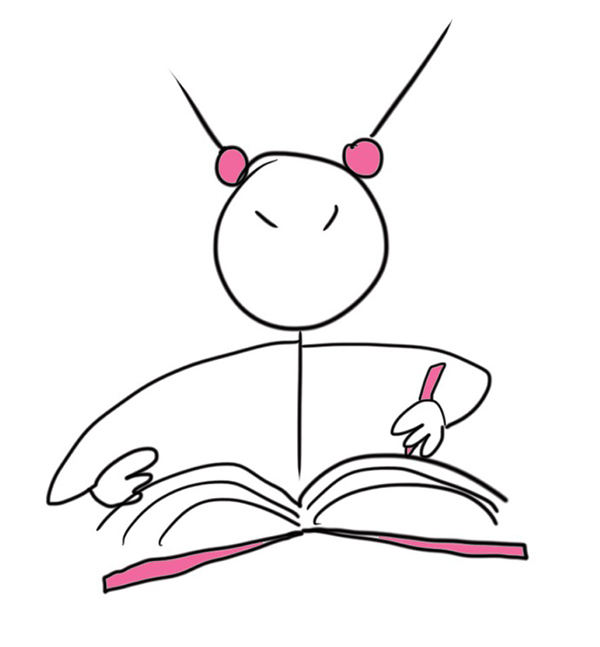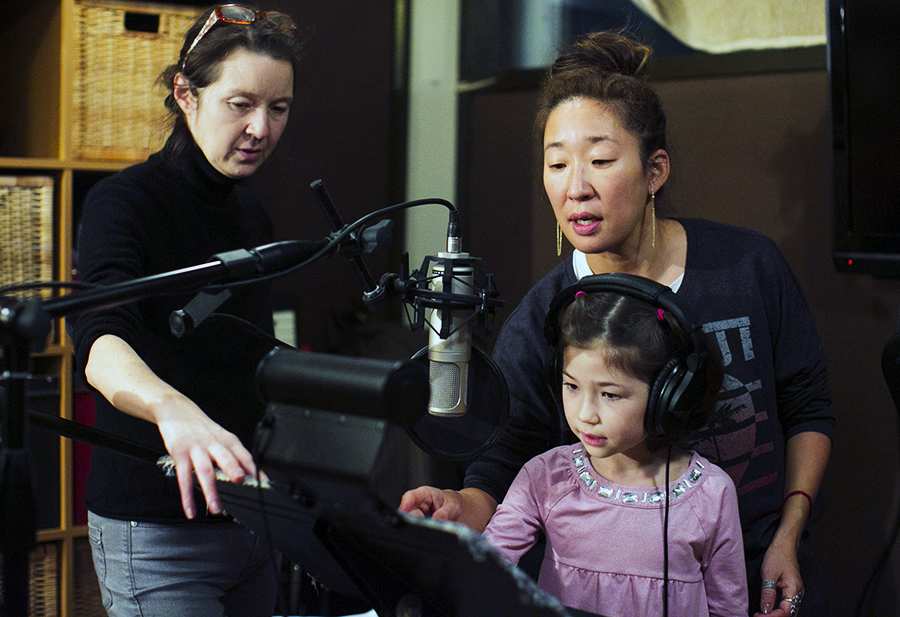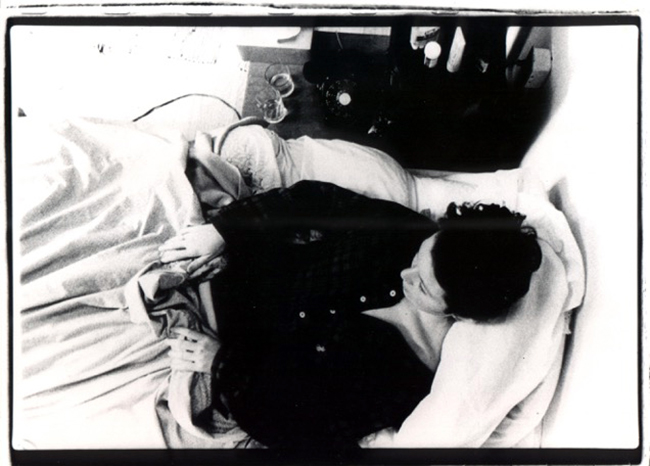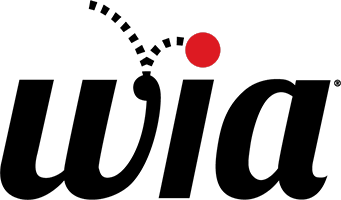SPOTLIGHT STORIES: ANN MARIE FLEMING
Interview conducted by Tracey Miller-Zarneke
Women in Animation (WIA) is pleased to shine a spotlight on filmmaker Ann Marie Fleming. Ann Marie has been very busy touring festivals with her feature length film Window Horses: The Poetic Persian Epiphany of Rosie Ming, but not too busy to present her short film “You Take Care Now” to WIA in its call for ROAR submissions. In fact, it is Ann Marie’s deeply moving short that led to this conversation, and we invite you to get more familiar with Ann Marie, her life experience, her perspective, and her work.
Please give us some background on how you came into the animation industry.
I have always been interested in film and in storytelling. As a child, I was as interested in how they did it as what they were doing. It didn’t really register when I was young, but on my maternal side, my grandfather was an amateur photographer in Hong Kong, and my great grandfather was a magician, and now I appreciate how those two mediums come together to give us animation. I attended Emily Carr University of Art + Design in Vancouver to study animation in my early twenties, inspired by a cut-out film by Martin Rose, “Study of an Apartment,” in which I saw a woman infuse a cup of hot water with a tea bag, all in paper cut outs. At that time, there were limited opportunities in the animation industry in Vancouver, which may have contributed to why I proceeded to make my own films.
Please give us a timeline, literal and emotional, of things that happened in your life, leading up to your creation of “You Take Care Now.”
My dad is Australian (Franco-Irish, I think) and my mum is from Hong Kong (she’s mostly Chinese with some Austro-Hungarian in there.) Somehow, I was born in Okinawa. My brother was born in Hong Kong two years after me, and we came to Canada when I was 5. That was hard. I experienced what many first generation children do: a generational and cultural disconnect between where my family came from, and where I was. After unsuccessful forays in the direction of medicine and law — those more acceptable immigrant career choices — I ended up with an English Literature degree from the University of British Columbia and made that privileged rite-of-passage post-grad European tour.
After that, I made a living, briefly, as an artisan — painting t-shirts, umbrellas, making jewelry, and doing amateur stand up. I saw Peter Greenaway’s film, A Zed and Two Noughts, and it had all these images from my dreams in it, and that’s when I knew I really wanted to go back to school and learn filmmaking. I was working part time as a telephone operator to help put myself through school, that’s where I met a woman with a very particular story, and a very irreverent way of talking about it. I wanted to make a film about this friend of mine, who was the survivor of a murder-suicide by her ex-fiancé, a case that contributed to changing the gun laws in Ontario. I wanted her to trust me with her story, so I thought I had to put myself personally on the line.
That’s why I decided to make “You Take Care Now” at the age of 26, as my grad film in animation. I was recovering from a car accident, where I had been hit and run over, and I had experienced being raped and sexually assaulted by several men a few years earlier while on those travels in Europe. These were not things I talked about: the car accident was obvious, as I was still using a cane, but the sexual assaults were invisible. But they were two traumatic violations that happened to me and I wanted to be able to acknowledge them on the same level, on my own terms, and in a way with which other people could identify. I had previously represented them in my first stickgirl film “So Far So…” an 80-second synopsis of my life, but everything was coded. Only I knew what was represented by seemingly jaunty narrative.
Now, I was going to say it loud and clear.
I was absolutely terrified, and I thought it would basically kill any possibility of me having a career. I really just aspired to making interstitials for Sesame Street, inspired by “Alphabet Rock.” (By the way, I did make two films about my friend’s experience, both called “New Shoes.” The short one, “New Shoes: An Interview in Exactly 5 Minutes,” won Best Canadian Short at the Toronto International Film Festival (TIFF) that year and is still screened in high schools and women’s and media studies courses across Canada. “You Take Care Now” is now on TIFF’s 150 essential viewing list.)
What sort of responses did you get to “You Take Care Now”?
I was so surprised: it was overwhelmingly positive and it was programmed everywhere. It seemed to be something that needed to be said. The film has a sense of humor and is about acknowledging human experience. After seeing “You Take Care Now,” a lot of women, including friends of mine, wanted to tell me about their own experiences with sexual assault. People revisited events in their past, finally able to say they had been raped. Some men told me that comparing the two experiences allowed them to have some glimpse into what it might be for a woman to experience sexual assault. At a women’s festival in Seattle, someone commented that I had created an unlikely scenario, being raped and run over in one lifetime. I asked the audience, mainly women, to raise their hands if they’d been raped—more than half of the hands went up. I asked who had been hit by a car and about a third of the audience did the same.
Of course, sexual assault is not only a woman’s issue. But it is always about power. I want people to be able to understand the violation that is rape regardless of the situation. “You Take Care Now” has been taught in film classes across Canada, inspiring other young women to tell their own stories — any kind of personal history in this diary-like, mixed media, animated way. It won a bunch of awards and became a very public film, where honestly, I made it for my friend. I didn’t think anyone, except my graduating class, would ever see it.
What made you bring “You Take Care Now” out for ROAR?
WIA Board member Jinko Gotoh was talking about WIA’s ROAR initiative, and I mentioned that I had made this piece that dealt with sexual assault back in 1989, and she encouraged me to submit it. I wasn’t sure that it fit in to the conversation that is going on now about sexual harassment and assault in the workplace, especially for those who work in media. But I think it is about the ability to speak out, without shame or reprisal, your truth. It is still a scary thing to do, for some of us.
You’ve adopted what some might consider a unique perspective on your traumatic experiences, can you share that with us?
“You Take Care Now” is a personal story, and I don’t claim to speak for others’ experience. My initial purpose was to gain trust and credibility from a future subject, but also to show that these stories are important, people need to hear them, and that they can affect change. As for myself, I needed to be able to acknowledge experiences on my own terms, and I do so not from the position of a victim but as a survivor, as someone who has had these experiences and gone on. Though I would not wish them on anyone else, they have made me a stronger, more compassionate person. I have more information about people, about myself…about how we carry things in the body and the mind, and also how we heal. Anything can happen to anybody: we are all so vulnerable and we all carry stories that we have to be asked to tell. We share so very much.
I am so lucky that I am a storyteller, because everything I have experienced informs my work, and I try and turn it into something useful. And it’s told with a sense of humor, because that is the way I can get people who don’t necessarily feel comfortable with a subject to put down their armor and really listen to what I have to say.
What words of advice do you have for those who are survivors of harassment?
We are not always in a situation to affect much change in our environment in the moment. We do not always have that power or agency. When we can, we should do it. We should speak out for ourselves, on behalf of others — and it is sometimes so much easier to speak out for others! But we also have to be kind to ourselves if we are not always up for the fight. We learn. We grow. We should be kind to ourselves and not judge ourselves harshly. Whatever we have gone through, whatever we are feeling… we are not alone.
When I returned home from Europe back when I was 22, I needed to tell friends and family about my experiences. Many were either freaked out about it and didn’t want to talk in depth, or were dismissive and saying things like “maybe you’ve learned something now” or “at least you’re not pregnant.” I saw a therapist about some effects I seemed to be having. He even suggested that if I’d reported it, it wouldn’t be considered rape, merely coercion. I thought “WTF!???” Now that I think back on it, I believe that my shock at his response was partially responsible for me making the film…so I guess I should say “thank you!”
People can be very resilient. It’s not like I was not emotionally affected by this but I was very much in survival mode. It did not affect my behavior or my trust in others because I was not going to let that happen. It was not my fault and I expect better behavior from other human beings. Most of the time, that has been borne out.
How has your life changed since you shared your short film?
I became a filmmaker. It’s what I’ve spent my entire life doing, telling my stories.
Tell us about your current project, Window Horses.
Window Horses: The Poetic Persian Epiphany of Rosie Ming follows the exploits of a young Canadian Chinese-Iranian self-published poet who is invited to a poetry festival in Shiraz, where she learns many truths about her father, who she thought abandoned her as a child.
It’s a story about building bridges between generations and cultures through the magic of poetry. And yes, it’s funny, too. It’s my love letter to the world, which just seems to need some gentle voices of kindness right now.
Has poetry always been important in your life?
I’ve always written poetry, since I was about 4. It’s how I expressed love and longing, curiosity and grief. And I’ve always loved reading it. When I first thought of this story 20 years ago during my artist residency in Germany, away from my culture and language, the adapted poetry of Rumi got me through every day, believe it or not. And I think everything we do can be poetry, everything has layers of potential meanings.
What compelled you to write and share that story as a feature film?
It’s a big story and it needed a big canvas that only a feature film could offer. As a filmmaker and as a person from many different cultures, I’ve had the privilege of travelling all over the world, sharing my stories with others and having respectful conversations about the different and overlapping ways we see the world, what kind of world we want to live in, and what kind of world we want to make. It’s a conversation we should be having all the time.
I really did want to make something that was healing — maybe harkening back to the medical career that was derailed by my inability to grasp calculus. I wanted to show the healing power of art, and of simply listening to each other. Portraying an outsider’s glimpse of the great culture of Iran was terrifying. But the film is ultimately a story about love.
How did you come up with the concept to work with different artists and their unique animation styles? What challenges or benefits did that collaboration bring to the project?
I’ve often worked with a hybrid way of storytelling and have worked with different artists since I made The Magical Life of Long Tack Sam, my animated documentary about my great grandfather who was a world-famous vaudevillian globe-hopping magician and acrobat. Window Horses is a film about the imagination, and about our ability to change our perceptions and our world by being open and curious. It’s all about our point of view. So it made sense to have the poetry and historical sections designed and animated by different artists, all bringing their own points of view and special ways of seeing things. Rosie’s world expands from very simple line drawings to a complex and rich mix of visual styles. The main story was designed by my long-time collaborator, Kevin Langdale, and I brought on other artists that I know and admire to work on the other segments. Film is a collaborative art form. Having different styles makes it all very transparent.
What has the response been to Window Horses?
I’ve travelled all over the globe with the film and it has gained amazing responses from audiences worldwide. It’s sometimes a hard sell to get people to come and watch a film about a stickgirl who goes to a poetry festival in Iran, but those who do see it — and they are as young as 4 and as old as… well, old— have loved it. They see that it is not about Iran, but it is about all of us. The film has been doing the circuit both in animation and general film festivals and has won a number of honors: audience awards in Greece, jury awards in Korea, humanitarian awards in Tennessee, Best Canadian Film in Vancouver, Best Canadian Screenplay from the Canadian on-line critics, Best International Film in Iowa, and recently won Best Animated Feature at the Asia Pacific Screen Awards in Brisbane.
What advice do you have for young people looking at animation or other artistic industries as their career field?
Do what you love. I believe in the power of “no.” Some “nos” make you stop, while others give you that fire that makes you want to try even harder. There has never been a better time to be an animator — there are so many different applications for your skills. Don’t just think the big studios or even film. Every industry wants to use animation as a storytelling/information tool because it is limitless in its creative possibilities.
How do you keep your artistic spirit refreshed, even when under the pressure of production deadlines or life challenges?
Well, that’s the secret, isn’t it? I am lucky enough to be compelled to do certain things. And it helps when you really believe in what you are doing. Window Horses is the most difficult thing that I’ve ever had to do, professionally. I think the film’s message of peace and tolerance, told from a perspective of a mixed race stickgirl who travels as a stranger to a strange land and finds her own voice, is a strong and necessary one.
I’ve heard a lot of “nos” on this path, for years. I finally got funding and support in so many other ways, in no small part because of the heartfelt participation of Sandra Oh. But the “yes” was always inside me.
WIA greatly appreciates the time and energy Ann Marie took to share her perspective and experience with our membership, and we wish her all the best with Window Horses and all her future endeavors.



